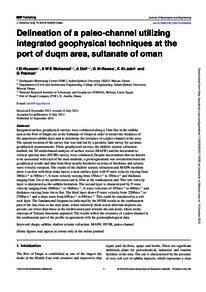وثيقة
Delineation of a paleo-channel utilizing integrated geophysical techniques at the port of duqm area, sultanate of oman.
المعرف
DOI: 10.1088/1742-2132/11/5/055005
المساهمون
الناشر
Institute of Physics Publishing.
ميلادي
2014-09
اللغة
الأنجليزية
الملخص الإنجليزي
Integrated surface geophysical surveys were conducted along a 3 km line in the sabkha area at the Port of Duqm site in the Sultanate of Oman in order to model the thickness of the uppermost sabkha layer and to determine the existence of a paleo-channel in the area. The spatial location of the survey line was laid out by a geodetic land survey for accurate geophysical measurements. Three geophysical surveys, the shallow seismic refraction method, the 2D multichannel analysis of surface waves (MASW) and the horizontal-to-vertical spectral ratio (HVSR) survey, were conducted. Despite uncertainties that are known to be associated with each of the used methods, a good agreement was revealed between the geophysical results and data from three nearby boreholes in terms of thickness and seismic wave velocity variation. The results of the shallow seismic refraction and MASW methods show a section with three main layers; a near-surface layer with P-wave velocity varying from 300 m s-1 to 500 m s-1, S-wave velocity varying from 150 m s-1 to 350 m s-1 and thickness ranging from 2 m at the northwestern end to 10 m at the southeastern end. This low-velocity layer is interpreted as the sabkha formation. The second layer is characterized by P-wave velocity ranging from 1000 m s-1 to 1600 m s-1, S-wave velocities of 450 m s-1 to 600 m s-1 and thickness varying from 4 m to 8 m. The third layer shows P-wave velocity from 2200 m s-1 to 2700 m s-1 and a shear wave from 650 m s-1 to 850 m s-1. This could be considered as a soft rock layer. The fundamental frequencies indicated by the HVSR results at the southeastern part of the line close to the start point, where relatively thick recent alluvium deposits are present, are lower than those at the northwestern part towards the end point, where rocky outcrops of Tertiary limestone appeared. The results reflect the existence of a paleo-channel at the southeastern part of the profile in agreement with the geomorphological data.
المجموعة
ISSN
1742-2132
URL المصدر
قالب العنصر
مقالات الدوريات



